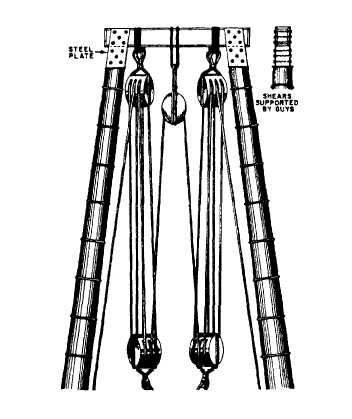allowance for friction, you multiply this result by 10, and then divide what you get by 10 plus the number of sheaves in the system.
Suppose you have a threefold purchase, a mechanical advantage of 6, reeved with a line that has a safe working load of 2 tons. Disregarding friction, 6 times 2, or 12 tons, should be the safe working load of this setup. To make the necessary allowance for friction, however, you first multiply 12 by 10, which gives you 120. This you divide by 10 plus 6 (number of sheaves in a threefold purchase), or 16. The answer is 7 1/2 tons safe working load.
Lifting a Given Weight
To find the size of fiber line required to lift a given load, use this formula:

C in the formula is the circumference, in inches, of the line that is safe to use. The number 15 is the conversion factor. P is the weight of the given load expressed in tons. The radical sign, or symbol, over 15 x P indicates that you are to find the square root of that product.
To square a number means to multiply that number by itself. Finding the square root of a number simply means finding the number that, multiplied by itself, gives the number whose square root you are seeking. Most pocket calculators today have the square root function. Now, let's determine what size fiber line you need to hoist a 5-ton load. First, circumference equals 15 times five, or C = 15 x 5, or 75. Next, the number that multiplied by itself comes nearest to 75 is 8.6, Therefore, a fiber line 8 1/2 inches in circumference will do the job.
The formula for finding the size of wire rope required to lift a given load is: C (in inches) = 2.5 x P (tons). You work this formula in the same manner explained above for fiber line. One point you should be careful not to overlook is that these formulas call for the circumference of the wire. You are used to talking about wire rope in terms of its diameter, so remember that circumference is about three times the diameter, roughly speaking. You can also determine circumference by the following formula, which is more accurate than the rule of thumb: circumference equals diameter times  In using this formula, remember that equals approximately 3.14.
In using this formula, remember that equals approximately 3.14.
Size of Line to Use in a Tackle
To find the size of line to use in a tackle for a given load, add one-tenth (10 percent for friction) of its value to the weight to be hoisted for every sheave in the system. Divide the result you get by the number of parts of the fall at the movable block, and use this result as P in the formula

For example, let's say you are trying to find the size of fiber line to reeve in a threefold block to lift 10 tons. There are six sheaves in a threefold block. Ten tons plus one-tenth for each of the six sheaves (a total of 6 tons) gives you a theoretical weight of 16 tons to be lifted. Divide 16 tons by 6 (number of parts on the movable block in a threefold block), and you get about 2 2/3. Using this as P in the formula you get

The square root of 40 is about 6.3, so it will take a line of about 6 1/2 inches in this purchase to hoist 10 tons safely. As you seldom find three-sheave blocks that will take a line as large as 6 1/2 inches, you will probably have to rig two threefold blocks with a continuous fall, as shown in figure 4-33. Each of

Figure 4-33. - Rigging two tackles with continuous fall.
Continue Reading